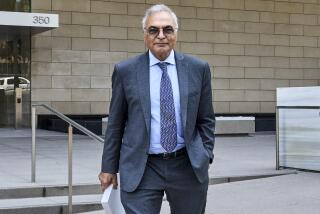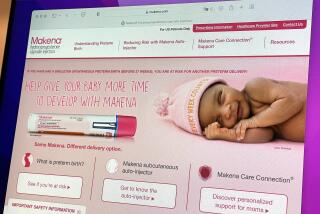FDA Panel to Consider Lifting Ban on Silicone Breast Implants
- Share via
WASHINGTON — Kristen Chase plays tennis, lifts weights and works out on cardio machines -- an ambitious fitness regimen for a mother of four nearing 40.
But nursing three sons and a daughter has changed the appearance of her breasts in a way exercise can’t fix, she said. So Chase has opted to have surgery to restore her figure, and she has decided silicone gel breast implants would look and feel better than the saline liquid-filled ones.
Her decision would be a simple one in many countries. But in the United States, the Food and Drug Administration bans the use of silicone implants for cosmetic surgery because of lingering suspicions about health risks.
This week, two California companies will go before an FDA advisory panel to seek a recommendation that could open the way to market silicone implants to the 250,000 American women who each year have surgery to make their breasts fuller.
Chase, who lives near Chicago, will be watching closely. She has delayed having the surgery, hoping the panel will ease the ban on silicone implants and the agency will then sign off on their use.
“I don’t want that top-heavy, unnatural look,” she said. “There are some women that you look at, and it’s flagrantly obvious their breasts are augmented. I am pursuing a natural, prior-to-having-children look, and saline does not provide that.” Silicone implants have become the choice of 90% of European women who have cosmetic breast surgery, industry figures show. But in the United States, they remain limited mainly to cancer patients having breast reconstruction.
In 2003, a FDA panel recommended approval of silicone implants for cosmetic surgery patients. But agency officials rejected that recommendation and requested more information from manufacturers.
The two Santa Barbara companies, Inamed and Mentor Corp., have produced data that they say show a low risk of complications, such as ruptures. But it’s not clear that the FDA will agree.
Even if it approves silicone implants, patients may be required to undergo costly MRI scans every year or two to detect ruptures.
Last week, staff reports released before the panel meeting questioned whether the industry’s new data could reliably predict that implants would not rupture after more than a few years in women’s bodies.
“The tone of those FDA documents was more negative than people expected,” said Amit Hazan, an analyst who follows the medical devices industry for the Atlanta investment firm SunTrust Robinson Humphrey.
Wall Street analysts noted that the chairman of the new FDA panel, Johns Hopkins cancer specialist Dr. Michael A. Choti, voted against silicone implants when he served as a member of the 2003 panel. Choti was not granting interviews, his office said.
For Inamed and Mentor Corp., millions of dollars are riding on the outcome of the three-day meeting.
The two U.S. silicone implant manufacturers have spent years trying to persuade the agency to allow them to sell their products to cosmetic surgery patients. Should they succeed, Hazan estimates the implant market would increase by about 20% next year, from $400 million to $475 million.
Market analysts predict that silicone implants, if approved, would quickly outpace sales of the liquid-filled ones.
The safety debate over silicone implants has been going on since the late 1970s. Lawsuits alleging that gel leaking from ruptured implants caused cancer and other diseases forced Dow Corning, a major manufacturer, into bankruptcy. The FDA imposed the current restrictions in 1992.
Since then, repeated scientific investigations have not found a cause-and-effect link between silicone breast implants and illnesses such as cancer, immune system disorders, connective tissue disease or neurological problems. A recent study found an association with fibromyalgia, a syndrome characterized by chronic muscle and joint pain, though that finding remained controversial among doctors.
Medical researchers have documented other kinds of complications, common to all implants. Breast tissue around an implant can contract, causing pain and deformation. Implants can rupture. Such problems require many women to undergo repeated operations.
“Breast implants do NOT last a lifetime,” says an FDA handbook for patients. “You should be prepared for long-term follow-up, re-operations to treat complications and personal financial costs.”
Supporters of silicone implants have concluded that their risks are outweighed by the benefits.
“I’ve never professed that anything man-made in terms of a medical device is perfect,” said Dr. James Wells, a Long Beach surgeon who heads a task force on breast implants for the American Society of Plastic Surgeons.
But Wells said that the task force was going to urge the FDA panel to approve silicone implants for general use.
“Women in 60 countries in the rest of the world have access to them, and 90% of the women choose silicone,” he said. “Why are American women restricted from making the decision for themselves?”
Consumer groups and some women’s health advocates argue that the long-term risks of silicone implants remain unknown.
“I don’t think the science can support approval,” said Diana Zuckerman, president of the National Research Center for Women and Families.
What happens when silicone implants break is of concern because such ruptures are not easily detectable. Saline liquid-filled implants deflate when they rupture, making a failure easy to see. But with silicone implants, the gel stays in the chest area and may be only absorbed into the body slowly.
These silent ruptures account for the majority of cases in which silicone implants fail.
The FDA staff’s conclusions raised concerns about the long-term risks of ruptures, despite the industry’s new data.
Although initial-rupture rates for Inamed implants are in the low single digits, the agency estimated that 10-year rates for cosmetic surgery patients could range as high as 38%. For breast reconstruction patients, facing more complicated surgery, the FDA staff estimated 10-year rates as high as 93%.
The projections are based on mathematical modeling that the company strongly disputes.
Uncertainties about the health effects of silicone breast implants long have marked the debate over them. Some women who have had the implants later have suspected their health was compromised, even in cases where no ruptures were found.
Brandy Markakis, a 29-year-old mother of two from Menifee, Calif., was never able to get an unequivocal medical diagnosis for the cause of her fatigue and body aches after she received silicone breast implants. One doctor said she might have fibromyalgia. “My boys couldn’t understand why Mommy didn’t feel good all the time,” she said. “I am a baseball fanatic, and my 11-year-old would say, ‘Mommy, you never play catch with me anymore.’ ”
She had considered herself lucky when she was able to get silicone implants through a clinical trial in 2001, after her saline implants caused painful contracture of her breasts. But after about a year and a half, her energy plummeted. Markakis said it felt as if she had a flu that she could not shake.
As she researched the problems other women reported about silicone implants, she became convinced they could have caused her malaise. About six weeks ago, she had her silicone implants removed. It turned out they were not ruptured, but Markakis said that her energy had steadily improved.
“I wish somebody had really sat me down and said it’s not like a 1-in-a-million chance of problems,” she said.
“Here I am, back where I started, all this money wasted. We must have spent $20,000 out of our own pockets.”
*
(BEGIN TEXT OF INFOBOX)
Surgical choice
Since 2000 cosmetic breast augmentations in the U.S. have grown 24%, while those performed for reconstructive reasons have declined 22%:
Cosmetic: 264,041
Reconstructive: 62,930
*
Top five procedures
Breast augmentation was the third most popular kind of cosmetic surgery performed in 2004. Number of procedures:
Liposuction: 324,891
Nose: 305,475
Breast augmentation: 264,041
Eyelids: 233,334
Facelift: 114,279
Note: Totals include procedures by physicians not board-certified in plastic surgery but who may perform operations.
Source: American Society of Plastic Surgeons.






